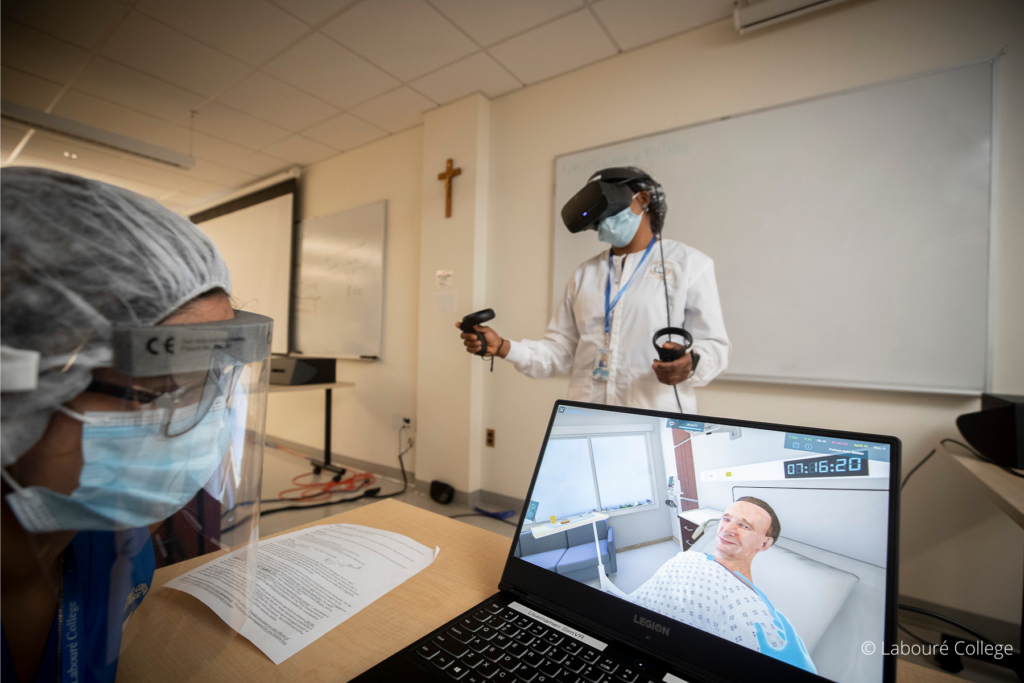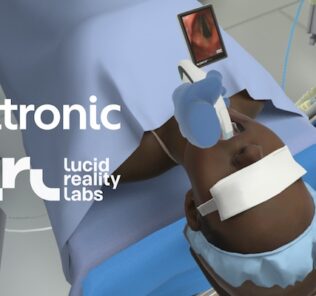Virtual Reality Platform UbiSim Helps Labouré Nursing College Overcome COVID-19 Restrictions
UbiSim, an immersive VR healthcare simulation training platform for nursing, partners with institutions worldwide to advance the shared mission of improving patient care and safety. As the coronavirus pandemic has forced a shift from standard clinical training to virtual and remote learning alternatives, UbiSim technology has provided learners with access to a complete virtual training center with realistic environments, patients and medical equipment. Here we take a look at Labouré College, an institution that chose to implement the UbiSim VR nursing educational platform to overcome COVID-19 restrictions.
Labouré College, a nursing program in Milton, Massachusetts provides quality education to over 800 learners each year. During the COVID-19 pandemic, these learners experienced an increased demand for healthcare simulation to supplement clinical training hours. The innovative college faculty employed UbiSim technology to deliver high-quality, immersive virtual reality clinical simulations that were scalable to the institution’s large program and that complied with social distancing guidelines.
In March 2020, Labouré College suspended in-person skills labs, clinicals and healthcare simulations due to the COVID-19 pandemic. Faculty faced the unprecedented challenge to provide high-quality clinical education while also adhering to the new social distancing and infection control guidelines. Faculty members needed a scalable solution that would safely fulfill clinical requirements across the program. Thus, manikin-based healthcare simulations were no longer a viable option for Labouré College during the lockdown.
Sponsored Content:
According to Karen Manning, Dean of the Labouré Division of Nursing, “Healthcare simulation manikins require a significant amount of cleaning between each student’s use, which is impossible and does not work for the size of our classes. Upon school reopening, healthcare simulation manikins were used but had to be limited due to the significant amount of cleaning between each student’s use and the decreased number of students allowed in an area.”
With UbiSim, Labouré faculty chose immersive virtual reality over a virtual, screen-based platform because of increased realism and interaction with the virtual patient. The institution also felt that immersive virtual reality would better support learners’ development of clinical judgment. By integrating UbiSim into their curriculum, faculty supplemented more than 10,000 clinical hours by delivering 1300 UbiSim sessions with 184 learners over the 2020 summer semester.
The platform seamlessly continued learners’ clinical education in a safe and realistic environment. Manning says she realizes that UbiSim created a healthcare environment in which the learners became fully immersed in the scenario as an active participant with a patient.
“A lot of the virtual, screen-based platforms lack functional fidelity and are often viewed as a game to students, where they keep clicking until they get [the answer] right, but they do not always think about what they are doing,” Manning said. “I want healthcare simulation to be much more realistic and immersive. I want [healthcare simulation] to be a critical thinking tool.”
Sponsored Content:
UbiSim Enhancing Learner Engagement
To enhance engagement, Labouré faculty rotated learners between assigned roles of the scenario participant, the computer operator playing standardized patient dialogue, and the observer taking notes. Learners debriefed between healthcare simulation scenarios, reflecting on ways to improve care of the virtual patient. In a deliberate practice model, learners improved their performance with each run of the scenario, highlighting the repeatability of immersive virtual reality healthcare simulations.
“Faculty were able to use UbiSim to evaluate competency and knowledge attainment as well as provide feedback related to clinical knowledge and critical-thinking skills,” Manning said. “They were able to bridge theory to practice and mimic what they would do if this were a real clinical situation in the hospital.”
A faculty-to-learner ratio of 1:6 provided a facilitated experience with judicious use of Labouré College faculty resources. According to Helen Shedden, the Labouré nursing lab coordinator, “Having students and faculty using UbiSim on campus is working beyond my best expectations.” By rotating learners’ roles and providing supplemental activities like concept maps, one UbiSim scenario even supplemented a six-hour clinical day.
Specifically, by using the Editor, a customizable authoring tool, Labouré College faculty implemented pre-made, evidence-based healthcare simulations from the UbiSim catalog. They were also able to quickly customize existing scenarios and create their own bespoke clinical simulations. Labouré College’s customized healthcare simulations provided a curated learning experience that focused on caring for underserved populations in the community.
“Scenario development is a lot quicker with the Editor than manikin-based software because [the solution] is logical and allows me to focus on designing the important aspects like the medical record and provider’s orders,” Manning said.
Moving forward, Labouré College faculty are inspired to deliver healthcare simulation education in a new way. The faculty plans to continue customizing healthcare simulations aimed at improving patient care and safety within the community. Immersive virtual reality medical simulation is well-received by the college’s learners, with user satisfaction being a critical strength of the UbiSim platform.
“Even if COVID-19 was not a factor, we will use UbiSim to reinvent how we do clinicals. By using scenarios based on common hospital admissions we feel [the solutions] would lead to improvements in patient care as students can go through an entire 2-year or 4-year nursing program without caring for a patient with certain common illnesses,” Manning said. “Most importantly as [the solution] provides a safe environment for learning and students love it.”
More About UbiSim
UbiSim is the leading immersive virtual reality training platform dedicated solely to nursing simulation. Headquartered in Montreal, Canada, UbiSim comprises a multidisciplinary team of professionals passionate about healthcare simulation and virtual reality. The company’s team includes nursing educators, healthcare simulation experts, engineers and 3D artists.
By combining evidence-based virtual reality healthcare simulations with the Editor, UbiSim empowers faculty to customize and design clinical simulations that are curated to meet learning objectives. The company continually strives to increase VR accessibility by empowering educators and simulationists to design and customize their own scenarios using our web-based Editor.
UbiSim will have a virtual booth at IMSH 2021, where the company will debut our new OB patient that is customizable across the childbearing spectrum, from the prenatal to postpartum period. The company will also preview new OB equipment, a cardiotocography monitor and OB scenarios. There is a new feature where partners can share their unique UbiSim scenarios with the community as well.
Learn More About UbiSim!
Today’s article was written in support with Gauthier Dubruel, the director of business and partnerships at UbiSim.
Have a story to share with the global healthcare simulation community? Submit your simulation news and resources here!
Lance Baily, BA, EMT-B, is the Founder / CEO of HealthySimulation.com, which he started in 2010 while serving as the Director of the Nevada System of Higher Education’s Clinical Simulation Center of Las Vegas. Lance also founded SimGHOSTS.org, the world’s only non-profit organization dedicated to supporting professionals operating healthcare simulation technologies. His co-edited Book: “Comprehensive Healthcare Simulation: Operations, Technology, and Innovative Practice” is cited as a key source for professional certification in the industry. Lance’s background also includes serving as a Simulation Technology Specialist for the LA Community College District, EMS fire fighting, Hollywood movie production, rescue diving, and global travel. He and his wife live with their two brilliant daughters and one crazy dachshund in Las Vegas, Nevada.
Sponsored Content:



















